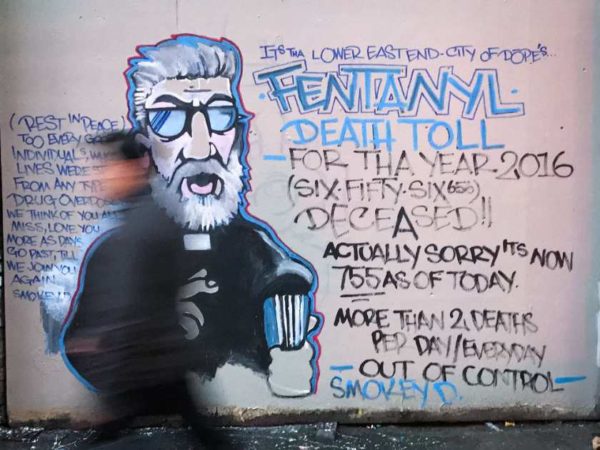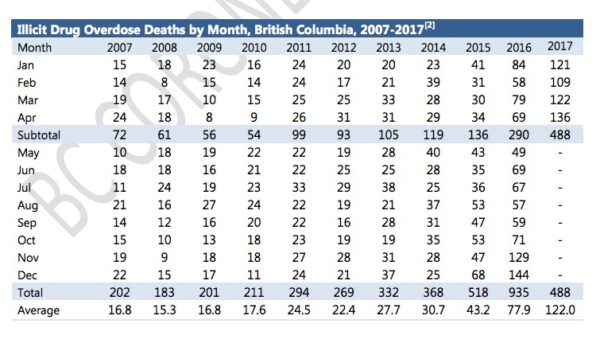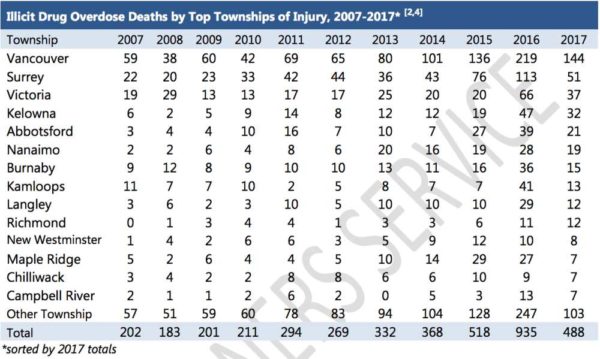B.C. Fentanyl opioid crisis: more than 1,400 overdose predicted deaths in 2017
August 9, 2017 · By SCOTT BROWN for vancouversun.com

A man walks past a mural by street artist Smokey D. about the fentanyl and opioid overdose crisis in the Downtown Eastside. DARRYL DYCK / THE CANADIAN PRESS
It’s been more than a year since B.C.’s provincial health officer Dr. Perry Kendall declared a public health emergency in response to a surge in drug-related overdoses and deaths, but the opioid death toll continues to climb at an alarming rate.
There were 488 illicit drug overdose deaths in B.C. during the first four months of this year, according to the latest data released by the B.C. Coroners Service.
If that pace continues, the number of overdose deaths in B.C. will surpass 1,400 in 2017, which would be a huge increase over the record 935 deaths recorded in 2016.
The report says 136 people died of suspected drug overdose in April alone, a rate of 4.5 deaths per day and a 97.1 per cent increase over the number of deaths occurring in the same month last year (69).
It was the second deadliest month on record in B.C., trailing only the December 2016 death total of 144.

Vancouver, Surrey and Victoria are the B.C. communities being hit hardest by the opioid crisis.
There were 144 overdose death in Vancouver alone between January and April, putting the city on pace for 432 deaths for 2017. In 2016, there were 219 overdose deaths in Vancouver, which was the highest total for any centre in B.C.
Victoria, which had 66 illicit drug overdose deaths in 2016, had 37 in the first four months of this year, while Surrey, which totalled 113 deaths in 2016, registered 51 deaths between January and April.

Nine in 10 illicit drug overdose deaths occurred indoors, including more than half in private residences (54.1 per cent). No deaths occurred at either of Vancouver’s supervised consumption sites — InSite or the Dr. Peter Centre — or at any of the drug overdose prevention sites.
“It is of great concern that despite the harm-reduction measures now in place and the public-safety messages issued, many people are still using illicit drugs in private residences where help is not readily available,” chief coroner Lisa Lapointe said in a release. “I strongly urge those using illicit drugs to do so only at a safe consumption site or drug overdose prevention site, if one is accessible.”
Lapointe also urged drug users to take only a small dose of the drug initially and only in the presence of someone willing and able to administer naloxone, a potentially lifesaving opioid antidote, and call 911.
Kendall, said those dying at home are not stereotypical drug users, but professionals and parents afraid to make their addiction known.
“There’s a degree of stigma around dependence or use of illicit drugs, which I think prevents those people from wanting anyone else to know that they’re using,” he told The Canadian Press. “It’s really significant that only 10 per cent of observed overdose deaths actually happened in a public place or on the street.”
Last week, Health Canada has approved applications from local health authorities to open three more supervised injection sites in Metro Vancouver.
The three new B.C. injection sites, which allow people to use illicit drugs under the supervision of a medical professional in case they overdose, will replace overdose prevention sites — two in Surrey and one in Vancouver’s Downtown Eastside — that were established by provincial health authorities as a response to a spike in overdoses and deaths.






